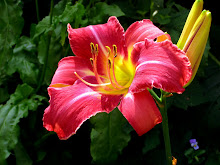
How many seedlings would you be willing to plant in the hopes of finding one special new hybrid? 10? 100? 1000? more?
The “big names” in daylily hybridizing typically make hundreds, maybe thousands of crosses and plant hundreds of thousands of seedlings each year. This, of course, requires acreage and employees and usually, a location south of the Mason-Dixon line.
But there are loads of backyard daylily growers who have a keen interest in hybridizing as well, who necessarily grow smaller numbers of seedlings, and sometimes produce a hybrid special enough to be registered.
Like so many, I started simply planting the random crosses accomplished by the flowers themselves. Those seed pods you find at the end of the season contain shiny black seeds, and if planted, many of them will germinate. The more varieties of daylilies you have, the more potential for each of these seeds to produce new and different varieties. Here in the north, seedlings will not flower the first year; this is one of those endeavors that helps to develop patience.
Most of my first batch of seedlings flowered in the second year. Like any new mother, I was entranced with my new “babies” – well, some of them, anyway! Experienced hybridizers advise waiting until the second or third year of flowering to really see what you’ve got – requiring even more patience *sigh*.
The next logical step was to purchase seeds from experienced hybridizers … and so I did. Some of those began flowering last summer: curly ruffled edges, interesting colors … whetting appetites to see what they’ll be like as second-year blooms.
Presently we have about 400 seedlings in various stages of growth. Not that many, in the world of daylilies, but more than enough to weed and fuss over. Watching them send up their first scapes is like looking at all the presents under the Christmas tree, wondering what's inside each one. Won't be too much longer now!

Wow. 400. Wow. I need different varieties, I think. The plain ol' orange ones are getting tired.
ReplyDeleteI think of the orange ones as the wild heirloom grandmothers of the newer cultivars ... although that's only partially true; there are a number of "original" species daylilies, originating in Asia, that have been used to hybridize for nearly a hundred years. The orange ones often get short shrift these days, but they're still stunning in their own way, and nearly indestructible.
ReplyDelete